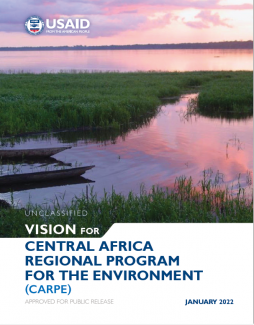Central Africa’s Congo Basin ecosystem is critical to the health, livelihoods, and security of more than 80 million people. Dense tropical forests and peatlands regulate the regional climate, providing rainfall and clean water across Africa and affecting weather patterns around the globe. These ecosystems also trap millions of tons of carbon and help mitigate global climate change. The peatlands of the lowland Cuvette Centrale, the central part of the Congo Basin, form one of the most carbon-rich ecosystems on the planet and are estimated to store 30 billion tons of carbon, equivalent to
almost a year’s worth of global emissions from fossil fuels. The Congo River, second longest in the world, delivers fresh water to people and wildlife,
is a major fishery, and forms the backbone of the region’s transportation system. Endangered wildlife species, such as forest elephants, chimpanzees, bonobos, and lowland and mountain gorillas, inhabit the forests of the Congo Basin, while a mosaic of woodland savannas provide habitat for lions, antelopes, buffalo, giraffes, savanna elephants, and many other species. Together, these terrestrial and aquatic ecosystems serve as habitat for more than 10,000 species of plants, 400 species of mammals, 1,000 species of birds, and 700 species of fish. The region is irreplaceable: 30 percent of its plant
species and 80 percent of fish species are found nowhere else in the world.

An official website of the United States government
Here's how you know
The .gov means it’s official.
Federal government websites often end in .gov or .mil. Before sharing sensitive information, make sure you’re on a federal government site.
The site is secure.
A lock () or https:// ensures that you are connecting to the official website and that any information you provide is encrypted and transmitted securely.
